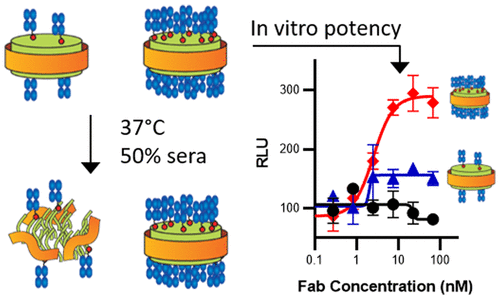当前位置:
X-MOL 学术
›
Bioconjugate Chem.
›
论文详情
Our official English website, www.x-mol.net, welcomes your feedback! (Note: you will need to create a separate account there.)
Nanolipoprotein Particles as a Delivery Platform for Fab Based Therapeutics.
Bioconjugate Chemistry ( IF 4.7 ) Pub Date : 2020-07-23 , DOI: 10.1021/acs.bioconjchem.0c00349 Martine Darwish 1 , Whitney Shatz 1 , Brandon Leonard 1 , Kelly Loyet 1 , Kathy Barrett 1 , Janice L Wong 1 , Hong Li 1 , Ryan Abraham 1 , May Lin 1 , Yvonne Franke 1 , Christine Tam 1 , Kyle Mortara 1 , Inna Zilberleyb 1 , Craig Blanchette 1
Bioconjugate Chemistry ( IF 4.7 ) Pub Date : 2020-07-23 , DOI: 10.1021/acs.bioconjchem.0c00349 Martine Darwish 1 , Whitney Shatz 1 , Brandon Leonard 1 , Kelly Loyet 1 , Kathy Barrett 1 , Janice L Wong 1 , Hong Li 1 , Ryan Abraham 1 , May Lin 1 , Yvonne Franke 1 , Christine Tam 1 , Kyle Mortara 1 , Inna Zilberleyb 1 , Craig Blanchette 1
Affiliation

|
Nanolipoprotein particles (NLPs), a lipid bilayer-based nanoparticle platform, have recently been developed for in vivo delivery of a variety of molecules of therapeutic interest, but their potential to deliver Fabs with valencies that exceed those of current multivalent formats has not yet been evaluated. Here we describe the development, optimization, and characterization of Fab-NLP conjugates. NLPs were generated with maleimide reactive lipids for conjugation to a Fab with a C-terminal cysteine. Of note, maleimide reactive lipids were shown to conjugate to the apolipoprotein when the NLPs were assembled at pH 7.4. However, this undesirable reaction was not observed when assembled at pH 6. Site-specific Fab conjugation conditions were then optimized, and conjugation of up to 30 Fab per NLP was demonstrated. Interestingly, although conjugation of higher numbers of Fabs had a significant impact on NLP molecular weight, only a minimal impact on NLP hydrodynamic radius was observed, indicating that particle size is largely dictated by the discoidal shape of the NLP. Fab-NLP viscosity and its stability upon lyophilization were also evaluated as an assessment of the manufacturability of the Fab-NLP. Significantly higher Fab concentrations were achieved with the Fab-NLP conjugates relative to another multivalent format (Fab-PEG conjugates). Fab conjugation to the NLP was also not found to have an impact on Fab activity in both an inhibitory and agonist setting. Finally, the stability of the Fab-NLP conjugates was evaluated in 50% serum and Fab-NLPs demonstrated increased stability, with >63% of Fab-NLP remaining intact after 24 h at Fab per particle ratios of 7 or greater. Our findings suggest Fab-NLPs are a promising platform for the targeted delivery of Fabs in a multivalent format and are compatible with established manufacturing processes.
中文翻译:

纳米脂蛋白颗粒作为基于Fab的治疗剂的递送平台。
纳米脂蛋白颗粒(NLPs)是一种基于脂质双层的纳米颗粒平台,最近已被开发用于体内递送多种具有治疗意义的分子,但尚未评估其以超过当前多价形式的化合价递送Fab的潜力。在这里,我们描述了Fab-NLP共轭物的开发,优化和表征。用马来酰亚胺反应性脂质产生NLP,以与具有C末端半胱氨酸的Fab缀合。值得注意的是,当在pH 7.4组装NLP时,马来酰亚胺反应性脂质显示与载脂蛋白缀合。但是,在pH 6组装时未观察到这种不良反应。然后优化了特定位点的Fab缀合条件,并证明了每个NLP最多可缀合30 Fab。有趣的是,尽管更多Fab的结合对NLP分子量有重大影响,仅观察到对NLP流体动力学半径的影响最小,这表明粒径在很大程度上取决于NLP的盘状形状。还评估了Fab-NLP的粘度及其在冻干时的稳定性,作为对Fab-NLP的可制造性的评估。相对于另一种多价形式(Fab-PEG缀合物),使用Fab-NLP缀合物可实现更高的Fab浓度。还没有发现Fab与NLP的结合在抑制和激动剂环境中都对Fab活性有影响。最后,在50%的血清中评估了Fab-NLP缀合物的稳定性,并且Fab-NLP显示出增加的稳定性,在Fab中每颗粒比为7或更大时,> 63%的Fab-NLP在24小时后保持完整。
更新日期:2020-08-19
中文翻译:

纳米脂蛋白颗粒作为基于Fab的治疗剂的递送平台。
纳米脂蛋白颗粒(NLPs)是一种基于脂质双层的纳米颗粒平台,最近已被开发用于体内递送多种具有治疗意义的分子,但尚未评估其以超过当前多价形式的化合价递送Fab的潜力。在这里,我们描述了Fab-NLP共轭物的开发,优化和表征。用马来酰亚胺反应性脂质产生NLP,以与具有C末端半胱氨酸的Fab缀合。值得注意的是,当在pH 7.4组装NLP时,马来酰亚胺反应性脂质显示与载脂蛋白缀合。但是,在pH 6组装时未观察到这种不良反应。然后优化了特定位点的Fab缀合条件,并证明了每个NLP最多可缀合30 Fab。有趣的是,尽管更多Fab的结合对NLP分子量有重大影响,仅观察到对NLP流体动力学半径的影响最小,这表明粒径在很大程度上取决于NLP的盘状形状。还评估了Fab-NLP的粘度及其在冻干时的稳定性,作为对Fab-NLP的可制造性的评估。相对于另一种多价形式(Fab-PEG缀合物),使用Fab-NLP缀合物可实现更高的Fab浓度。还没有发现Fab与NLP的结合在抑制和激动剂环境中都对Fab活性有影响。最后,在50%的血清中评估了Fab-NLP缀合物的稳定性,并且Fab-NLP显示出增加的稳定性,在Fab中每颗粒比为7或更大时,> 63%的Fab-NLP在24小时后保持完整。



























 京公网安备 11010802027423号
京公网安备 11010802027423号